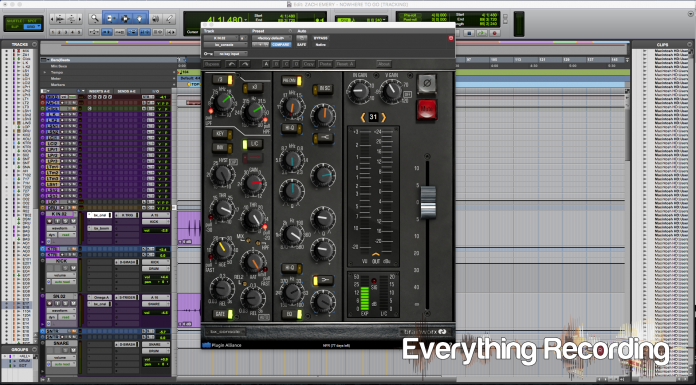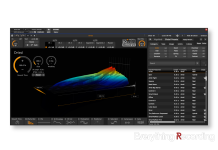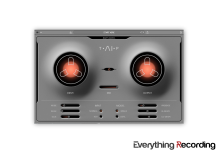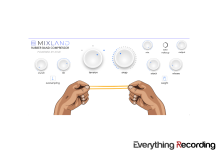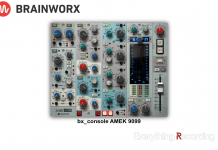I’m going to just come out and say it: for the most part, channel strip plugins have missed the mark. Sure, companies can model a channel of an SSL or Neve and sound very close, but they miss a very important aspect of what makes these consoles great: “subtle variation”. This is due to the tolerances in parts that make up each channel. The same components are used on each channel, but each component behaves slightly different in each channel, thus creating subtle changes between channels. This entropy in the system is partially responsible for the depth in mixes due to the randomness between channels on a specific mixer. This is even what attributes to certain consoles sounding better than the exact same model. This sometimes is responsible for “buyer’s remorse” when purchasing a console based on one that was heard at another studio – that and the maintenance cost and electricity bill.
Dirk (founder of Brainworx) has shouldered all of these burdens and has created a channel strip that addresses everything that plugin companies have either overlooked or just didn’t have the patience to address. bx_console is based on the Neve VXS Console that resides in Brainworx’s studio. This unit has quite a history including living at Skywalker Ranch’s sound stage for orchestra tracking and in Sweden, housed at an ex- Abba member’s personal studio. This console is a “best of both worlds” console bridging the gap between the older 80 series Neves and the newer 88RS. Dirk acquired this VXS a few years ago and instantly fell in love with the sound. This console has been involved heavily in the development of most of Brainworx’s plugins so it’s safe to say Dirk knows the subtleties and character of it.
The difference between this channel strip plugin and others is that instead of modeling just the best sounding channel, Brainworx modeled 72 different channels, each with the slight differences in tone and behavior. This very impressive feat comes courtesy of Brainworx’s own “Tolerance Modeling Technology” that captures everything that makes the channel unique, down to the phase differences and unbalanced center frequencies between channels. What is left is a 72 channel plugin that contains slight tonal differences between each instantiation, but bx_console doesn’t stop there. Brainworx crawled even further under the hood and added features to improve flexibility and creativity across the sections of the channel strip.
Interface:
bx_console is housed in a sleek gray-black window, complete with clickable LEDs, knobs, and glossy buttons, giving the feel of a real channel strip (even down to the toothpick wedged into the EQ shelf button of some channels). Meters and buttons are placed judiciously throughout the GUI, as not to overstimulate, but provide much needed feedback. This part of designing the interface can easily go awry, but Brainworx have truly packed everything into a logical, organized space. The stereo version of this plugin even features the mid and side solo section featured in other bx plugins. Since this channel strip, at first, can look rather daunting, we will break each section up and further expand on each function as well as added feature.
Filters:
In true spirit of tactile functions, the high and low pass sections feature a “pull to enable” function so by double clicking the knob or clicking the LED next to each filter, the HP or LP filter will engage and the knob will appear to pull upwards (it’s the little things right?). Although the original VXS will only allow for high passing to 315Hz and low passing to 7.5 kHz, bx_console extends these by multiples of 3 by pressing either the “/3” or “*3” buttons next to each respective filter. This extends the high pass all the way to 945Hz and the low pass to 2.5kHz, giving a lot more space to clear out instruments that contribute nothing to the particular frequency. Since bx_console is improving on the original, a variable slope would have been useful, but honestly, the fixed Q does the trick on 99% of content without leaving or taking away too much from the track.
Gate:
What console is complete without a gate or expander section? Vertically down the left half of the section below the filters lies the gate. At the top of this section sits the “key” button which gives the option to either internally trigger the gate or “key” it within your DAW. Engaging this button will illuminate the button and allow for the DAW to take over on triggering. The “INV” button will inverse the gate, thus bringing up the parts that the gate would usually catch, perfect for pumping effects on a parallel channel. The “HYST” knob sets a constant threshold that opens the gate. If “HYST” is turned all the way counter clockwise, the gate becomes an expander. The “THR” sets the threshold of the gate and can be increased by -30 by clicking the LED or double clicking the “THR” pull knob. “RGE” knob controls the maximum range that gating occurs complete with a “Fast” LED that activates a fast attack. Release does just what the knob says and the “Gate” button enables or disables the entire section.
This gate is a little more useful than most due to the bonus controls and added range of some of the controls. Not only can this gate help eliminate bleed from a kick mic, but it can also provide rhythmic effects when triggered externally to a drum buss or other instrument. A mix knob similar to the knob on a compressor could increase the creative function of this section even more by tucking the rhythmic gate into the track for subtle movement, but the range can accomplish this to an extent. Another great use of the gate is in conjunction with the “V Gain” knob, which injects a little analog noise into the circuit. Dialing the V Gain and gate together can give depth to a track by allowing a little noise to come through when audio is present in the track but silence during quiet parts.
Dynamics:
Expanding on the already incredible dynamics section of the VXS, the compressor / limiter section on the right half of the gate section features a few extra tricks up its sleeve with a compressor sidechain and mix knob. The compressor features all of the normal trappings of most other console compressors like input gain, threshold, and release but it is the added features that make this dynamics section perfect for almost any application. The sidechain is enabled with the “L/C” knob and is controlled via the tiny “HPF” control next to the “Mix” control. This HPF control can high pass up to 2kHz, almost allowing for de-essing. The Mix is controlled by the tiny “Mix” control under the threshold and can save precious time and channels by placing parallel compression right in the interface. The L/C Link only works in stereo or surround mode and links the compressor’s sidechain behavior between two of the modeled channels, thus giving a more uniform behavior of the detector on each side. This does not mean that in “Analog” mode that both sides of the stereo channel will compress the same. The same variances of each channel’s compressor will be present unless the “Analog” button is deselected, then both sides will compress the exact same way. L/C Link only aids the detector but can be a very powerful tool. The Ratio can go from 1.0:1 all the way to 97.4:1 for all out limiting. The attack is fixed at 1ms but when the ratio knob is pulled can increase to 0.1ms. The hardware section of the VXS features a two stage release, with one being fixed and not controllable, but Brainworx have made both controllable by adding the main release and “REL2” which defines a second threshold at which the release curve changes. An auto release feature is also available as well, giving endless possibilities and very transparent compression.
EQ:
One of the first buttons on the EQ is one very familiar to those who use an SSL Channel Strip. The “Pre/Dyn” button places the EQ before the dynamics section and can completely change the way content sounds. Another unique button is the “In SC” button which brings the EQ curve into the sidechain of the compression. These features coupled with four bands of EQ can both carve and enhance material with ease.
Output:
Even the output section has extras. This section actually makes this plugin stand out from the others. The “In Gain” controls how hard the gain is driven into the plugin and the “V Gain” adds noise characteristic of analog gear. This control, paired with the Gate can dial in extra vibe on tracks that feel too digital. The TMT section is where things get really fun. In this module are 72 unique channels of VXS, each with their own non-linearities and subtle changes in tolerances. Go ahead, apply compression and EQ to a channel and switch through some. Noticeable differences can be heard between channels, adding different phase relationship and center frequencies. This is accomplished via Brainworx modeling everything down to the interaction of the op amps and resistors then randomizing the tolerances to create slight differences in channels, but if this is not wanted (WHY would you not?!!) it can be turned off by clicking the “Analog” button above the fader. Finally, the output fader trims or adds volume to the final output signal.
Overall Thoughts:
What’s not to love?! It’s extremely obvious a lot of detail and digital blood, sweat, and tears have gone into making this plugin. No expense was spared. Sonically, bx_console N never disappoints. The sheer amount of diversity this plugin gives is astonishing. Besides reverb and delay, bx_console can mix entire records across all genres. It is truly everything it needs to be exactly when it needs to be it. One would think that all of the controls would be overwhelming but upon spending 30 minutes with the 17-page manual, everything immediately makes sense. I have absolutely no criticism of the plugin at all, only enhancements I’d personally like to see. I would like to see an expanded TMT section similar to the new EQ Ranger Plus with dropdowns for certain channels optimally used for particular instruments. I’m positive that Dirk knows this board so well that he stages certain instruments on certain channels. Also, a “random” button would be fun because sometimes after about 25 clicks, I lose patience and probably miss out on some of the higher number channels. Numbers can be manually entered, but sometimes random is a great thing. I’d also like a presets menu with settings catered to instruments, styles, and even creative use of the gate.
These are all operational and do not take away from the huge sound bx_console produces. The dynamics section can be as much in your face or transparent as you need with the expanded controls. The gate is one of the easiest gates I’ve ever used and the EQ… The EQ begs to be cranked and is very forgiving. There were times I couldn’t believe I had the knobs as wide open as I did but the sound was immense. The low end of this plugin is unlike any other digital EQ I’ve used. Simply turn up the low end on the right tracks and visceral bass shoots out of the speakers. The lows are very focused and do not get in the way of other tracks like other EQ’s. I’ve had issues in the past getting drums to play nice with bass, but with a little filtering and adding the right frequency of lows in each track, your low end has never sounded better. This plugin hasn’t left my drum buss since getting it.
The plugin has actually found its way on most of my tracks especially given what little processing each instance used. Just to test out bx_console, I placed it across 30 tracks and Pro Tools didn’t even budge, even when I was slamming the compressors and running the EQ pretty heavy. I have another channel strip plugin I use regularly that kills my CPU with just 5 instances and it doesn’t have half the mojo bx_console has.
Brainworx have really hit this one out of the park. How have we been mixing without bx_console this whole time? This plugin can easily replace countless plugins in your mix and definitely deserves at least getting a trial and kicking the tires. Just be warned, have some money set aside because you’re going to immediately want to buy this.
For more information, visit https://www.plugin-alliance.com/en/products/bx_console.html



